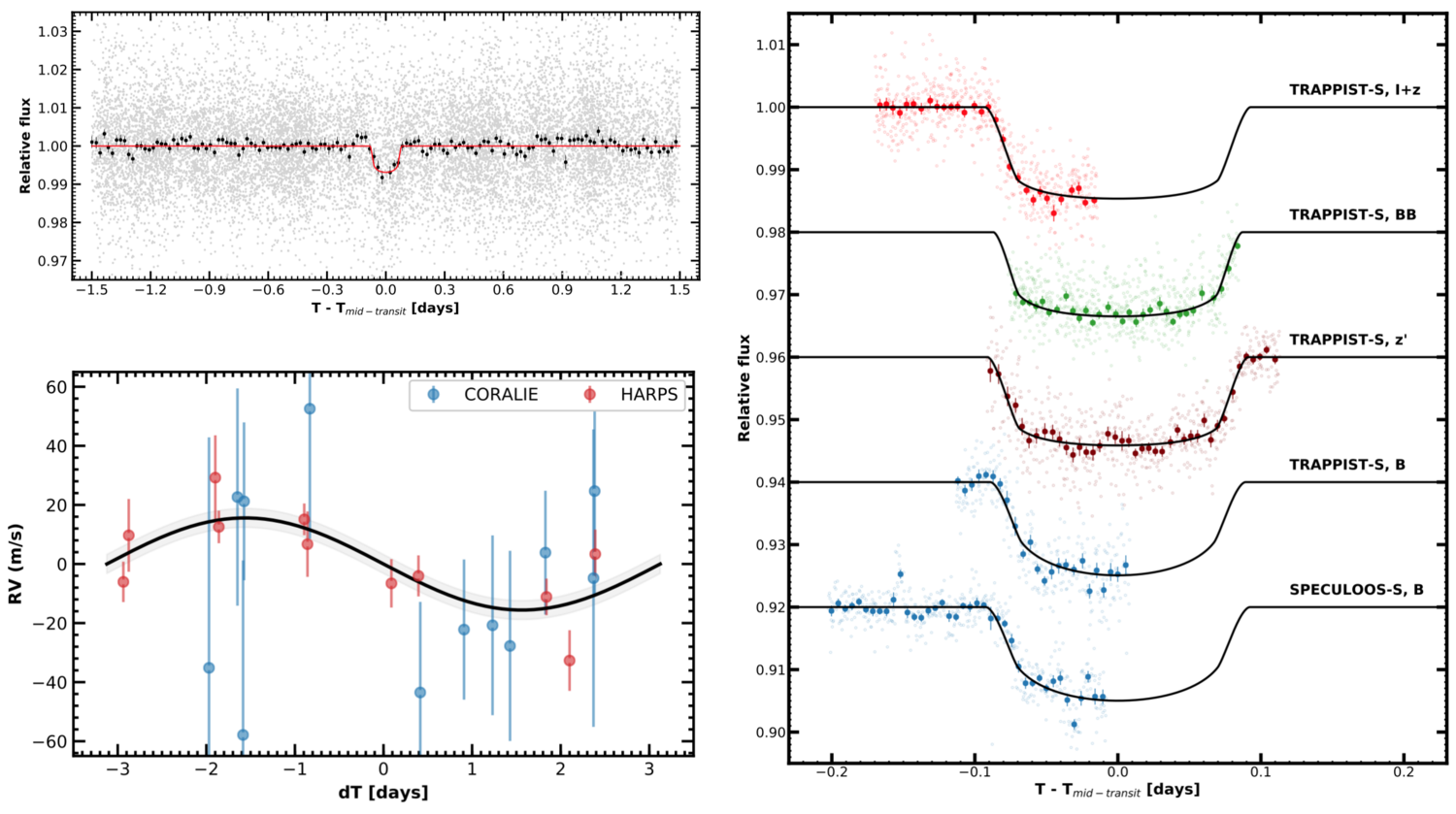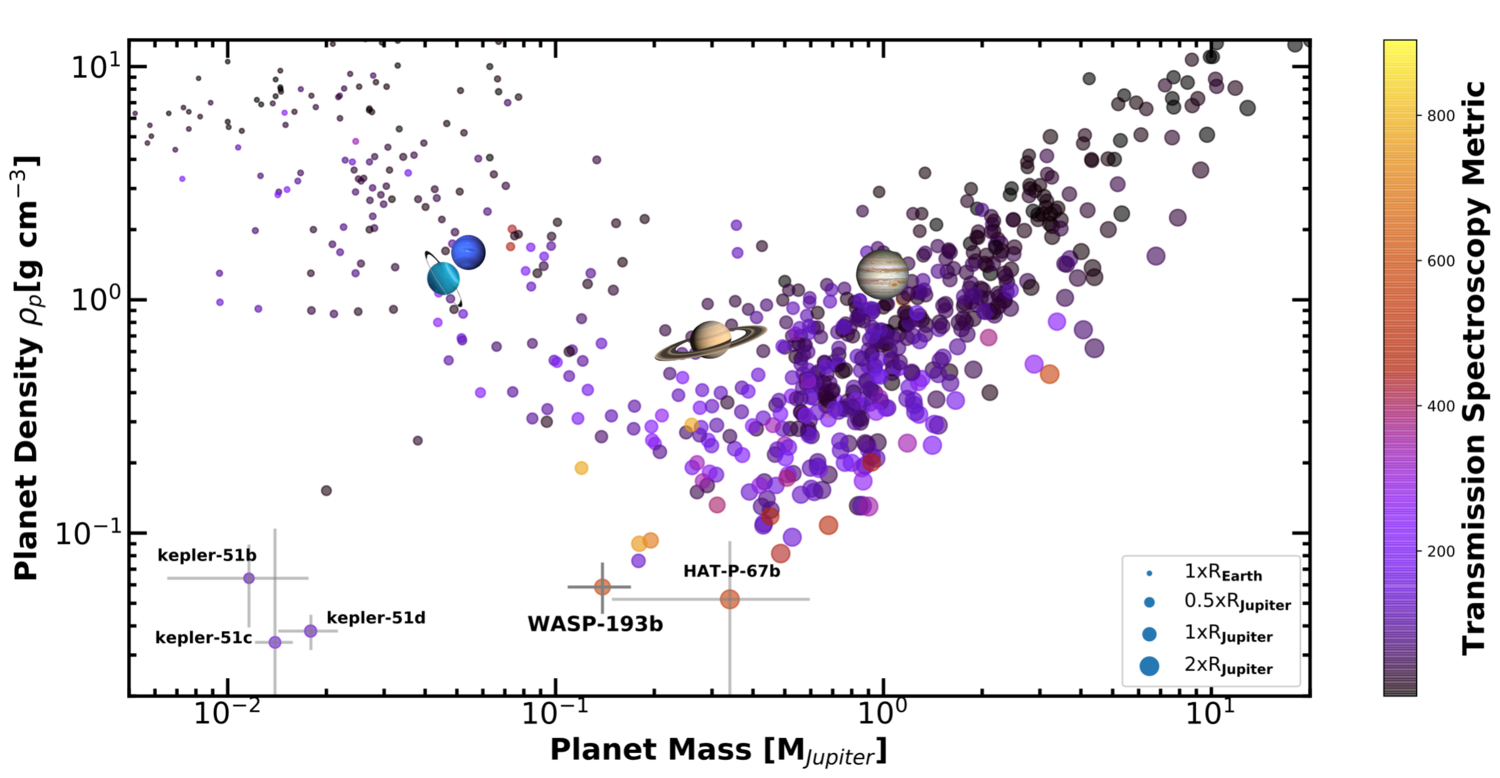WASP-193b: An extremely low-density super-Neptune
- 1Astrobiology Research Unit, Astrophysics, Geophysics and Oceanography, Belgium (khalid.barkaoui@uliege.be)
- 2Department of Earth, Atmospheric and Planetary Science, Massachusetts Institute of Technology, 77 Massachusetts Avenue, Cambridge, MA 02139, USA
- 3Instituto de Astrofísica de Canarias (IAC), 38205 La Laguna, Tenerife, Spain (khalid.barkaoui@uliege.be)
- 4Space sciences, Technologies and Astrophysics Research (STAR) Institute, Université de Liège, Belgium
- 5Astrophysics Group, Keele University, Staffordshire, ST5 5BG, UK
Super-Neptunes straddle between ice and gas giants, with masses between that of Neptune and Saturn, and their study can contribute to a better understanding of exoplanetary systems' formation and evolution. Here we present a new transiting super-Neptune discovered by the WASP-South [1] transit survey, WASP-193b (K. Barkaoui et al. Submitted in Nature Astronomy). Photometric follow-up was performed by the TRAPPIST-South [2] and SPECULOOS-South telescopes [3] (right panel in Fig. 1) and spectroscopic measurements were collected by the HARPS [4] and CORALIE [5] spectrographs (bottom left in Fig. 1). We performed a joint analysis of the light curves and radial velocity time series using the MCMC [6] algorithm to constrain the system's physical properties. WASP-193b completes an orbit around its F9V-type host star every 6.25d. Its mass is 0.14 ± 0.03MJupiter (i.e. 2.6 MNeptune) and its radius is 1.46 ± 0.06 RJupiter, which translates into an ultra-low density of 0.060 ± 0.014 g cm-3 (Fig. 2).
Its huge radius cannot be reproduced by standard models of irradiated gas giants [7], even when assuming a coreless structure. A mechanism of energy deposit into its interior (e.g. Ohmic dissipation or tidal heating) has to be advocated to explain its bloated state. Its high equilibrium temperature (Teq = 1254 ± 31 K), combined with its super-low density and the infrared brightness (Jmagnitude = 10.95) of its host star, make WASP-193b an exquisite target for a thorough atmospheric characterization with HST and JWST. The measurement of its orbital obliquity could also inform us of its dynamical history [9], shedding light on its energy budget evolution.

Fig. 1: Top left panel: Detrended discovery light-curve of WASP-193 obtained with WASP-South (gray points: unbinned and black points: bin width = 30min), period-folded using the orbital period deduced from our data analysis. Right panel: Follow-up transit photometry of WASP-193b. Four transits observed by TRAPPIST-South and one by SPECULOOS-South, period-folded using the best-fitting transit ephemeris deduced from our global MCMC analysis. Each individual transit light curve has been corrected by the baseline model. The coloured points are data binned to 7.2min and the best-fitting model is superimposed in red. Right panels: Residuals from the fits for each transit light curve. Bottom left panel: RVs obtained with the CORALIE (blue) and HARPS (red) spectrographs for WASP-193 period-folded using the best-fitting orbital model is superimposed as a solid line (in m s-1).
| Parameter | Value | Unit |
| Stellar paramaters for WASP-193 | ||
| Mean density ρ* | 0.557 ± 0.049 | Solar density |
| Stellar mass M* | 1.059 ± 0.077 | Solar mass |
| Stellar radius R* | 1.239 ± 0.028 | Solar radius |
| Planetary paramters for WASP-193b | ||
| Planet/star area ratio (Rp/R*)2 | 1.411 ± 0.085 | % |
| Orbital period | 6.2463345 ± 0.0000003 | days |
| Scaled semi-major axis a/R* | 11.74 ± 0.35 | Solar radius |
| Orbital semi-major axis a | 0.0676 ± 0.0015 | AU |
| Orbital inclination ip | 88.49 ± 0.65 | deg |
| Eccentricity e | 0.056 ± 0.055 | |
| Planetary density ρp | 0.0587 ± 0.0140 | g cm-3 |
| Surface gravity log gp | 2.22 ± 0.10 | cgs |
| Planetary mass Mp | 0.139 ± 0.029 | Jupiter mass |
| Planetary radius Rp | 1.464 ± 0.058 | Jupiter radius |
| Equilibrium temperature Teq | 1254 ± 31 | K |
| Irradiation | (5.62 ± 0.54)x105 | W m-2 |
Table. 1: The WASP-193 system parameters derived from our global MCMC analysis (medians and 1σ limits of the marginalized posterior probability distributions).

Fig. 2: Mass--density diagram of known transiting exoplanets from NASA Archive of Exoplanets. The size of the points scales with the planetary radius. The points are coloured according to their Transmission Spectroscopy Metric (TSM, [9]). WASP-193b is shown with its corresponding error bars. We highlighted also least dense planets known to date are labelled: Kepler-51b, Kepler-51c, Kepler-51d [10] and HAT-P-67b [11]. Giant planets of the Solar System are also shown.
References
[1] Pollacco, D. L., et al. 2006, PASP, 118, 1407
[2] Gillon, M., et al. 2011, EPJ Web of Conferences, 11, 06002
[3] Jehin, E., et al. 2018, The Messenger, 174, 2
[4] Francesco, P., et al. 2000, Proc. SPIE Vol. 4008, p. 582-592
[5] Queloz, D., et al. 2000, Springer-Verlag, p. 548
[6] Gillon, M., et al. 2012, , 542, A4
[7] Fortney, J. J., et al. 2007, , 659, 1661
[8] Triaud, A. H. M. J., et al. 2010, , 524, A25
[9] Kempton, E. M. R., et al. 2018, PASP, 130, 114401
[10] Masuda, K. 2014, , 783, 53
[11] Zhou, G., et al. 2017, , 153, 211
How to cite: Barkaoui, K., Pozuelos, F. J., Gillon, M., Coel, H., and teams, W. T. S. H. A. C.: WASP-193b: An extremely low-density super-Neptune, Europlanet Science Congress 2022, Granada, Spain, 18–23 Sep 2022, EPSC2022-709, https://doi.org/10.5194/epsc2022-709, 2022.

